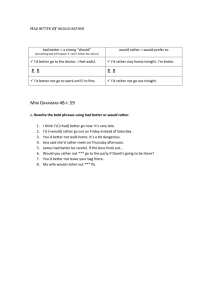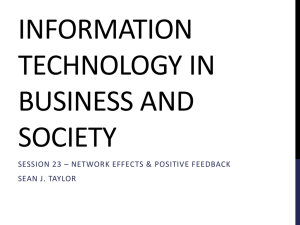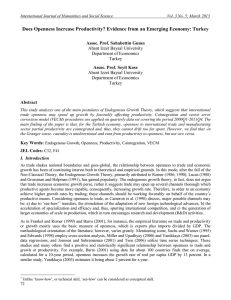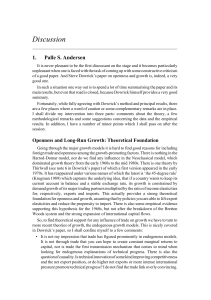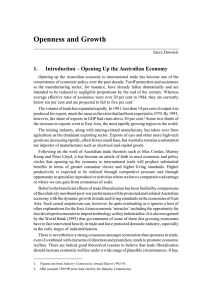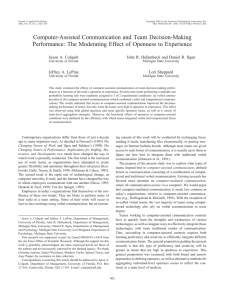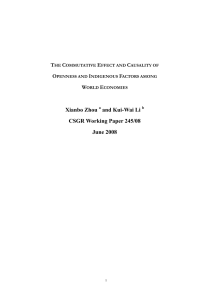communication
advertisement
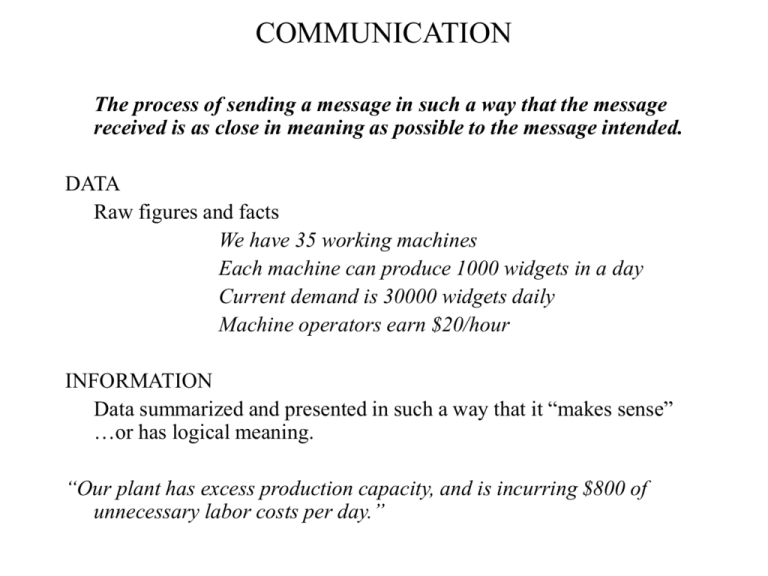
COMMUNICATION The process of sending a message in such a way that the message received is as close in meaning as possible to the message intended. DATA Raw figures and facts We have 35 working machines Each machine can produce 1000 widgets in a day Current demand is 30000 widgets daily Machine operators earn $20/hour INFORMATION Data summarized and presented in such a way that it “makes sense” …or has logical meaning. “Our plant has excess production capacity, and is incurring $800 of unnecessary labor costs per day.” CHARACTERISTICS OF USEFUL INFORMATION ACCURATE The information is precise…it reflects reality…it can be trusted …it’s true! TIMELY The information can be made available to the manager in time for appropriate action. If it takes too long to get it…it won’t be helpful. COMPLETE The information is all here…nothing important has been omitted. RELEVANT Is this information really needed by the manager? Will this knowledge aid the decision-maker…or will it confuse or distract him/her? THE COMMUNICATION PROCESS KEY PARTS OF THE COMMUNICATION MODEL • • • • • • • • SENDER -- initiator of the message ENCODING -- creating a message we want to send MESSAGE -- the specific words, signals, and images we send CHANNEL -- the method of delivery of the message DECODING -- translating, interpreting the meaning RECEIVER -- the target of the message NOISE -- signals which compete with (disrupt) the intended message FEEDBACK -- checking to be sure the message was understood INTERPERSONAL COMMUNICATION ORAL COMMUNICATION Managers spend 50 – 90% of their time talking to people. 55% of managers don’t feel their written communication skills are very good…so they use oral communication to avoid embarrassment. ADVANTAGES • Promotes prompt feedback and clarification…listen/watch to see whether they understand. If not, questions will be asked, etc. • It’s easy…you don’t need a computer…all you have to do is talk. DISADVANTAGES • Sender may leave out important details • Noise may distort the process • The receiver may forget part of the message • There is no permanent record of what has been said BARRIERS TO COMMUNICATION SEMANTIC PROBLEMS (WORD MEANINGS) LANGUAGE VOCABULARY TECHNICAL JARGON Bits, bytes, bauds, bandwidths...does OB = obstetrics or organizational behavior? POLITICALLY CORRECT TERMINOLOGY Follically challenged, people of gender, visually impaired negative patient outcome, vertically challenged, caloric overload CLICHES AND FILLER “That’s the way the cookie crumbles”…“That’s water under the bridge” Yadda, yadda, yadda”…“Like, you know…”… “sure, whatever” TECHNICAL PROBLEMS DISTRACTIONS AND INTERRUPTIONS PHYSICAL BARRIERS AND DISTANCE ABSENCE OF FEEDBACK (no signal) STRUCTURE OF GROUP NETWORKS POOR CHOICE AND USE OF COMMUNICATION CHANNELS Upward, downward or lateral? “Rich” vs “Lean” Channels SMALL-GROUP COMMUNICATION NETWORKS CRITERIA CHAIN WHEEL ALL CHANNEL Speed Moderate FAST FAST Accuracy Moderate HIGH Moderate Emergence of a Leader Moderate HIGH Low Member Satisfaction Moderate Low HIGH Centralized Decentralized COMMUNICATION TOPICS ORAL • WORK DISPUTES • DISCIPLINARY ISSUES • SENSITIVE PERSONAL MATTERS • ANYTHING THAT CAN BE EASILY MISUNDERSTOOD WRITTEN • GENERAL REPORTS • ROUTINE ANNOUNCEMENTS • GENERAL INFORMATION (FYI) COMBINATION (USE BOTH) • DIRECTIVES OR ORDERS • PERFORMANCE APPRAISALS • POLICY OR RULE CHANGES CHOICE OF CHANNELS DOWNWARD FOLLOWS THE CHAIN OF COMMAND – FORMAL HIERARCHY LESS LIKELY TO BE FILTERED OR DISTORTED LEAVES LITTLE OPPORTUNITY FOR FEEDBACK (ONE-WAY) UPWARD ACHIEVEMENT OF OBJECTIVES, PERFORMANCE REPORTS UNRESOLVED PROBLEMS …unless the Boss will be upset! SUGGESTIONS AND IDEAS FOR IMPROVEMENT ATTITUDES AND FEELINGS OF WORKERS LATERAL ESSENTIAL FOR COORDINATION AND INTEGRATION SAVES TIME BY SHORT-CUTTING THE VERTICAL HIERARCHY (TO EXPEDITE ACTION) FORMAL vs INFORMAL USE OF OFFICIAL CHANNELS GRAPEVINE Usually is 75-95% accurate COMMUNICATION CHANNELS ARE THESE DOWNWARD, UPWARD, LATERAL, FORMAL OR INFORMAL? REPORTS PROCEDURES & HANDBOOKS NEWSLETTERS PERSONAL LETTERS PAY INSERTS POSTERS & BULLETIN BOARDS MEMOS & FLYERS E-MAIL VOICE MAIL INTERCOM (LOUDSPEAKERS) SPECIAL MEETINGS INFORMAL DISCUSSIONS ONE-ON-ONE MEETINGS MORALE QUESTIONNAIRES GRAPEVINE SUGGESTION BOXES GRIEVANCE SYSTEM HIERARCHY OF CHANNEL RICHNESS ROUTINE, CLEAR, UNAMBIGUOUS MESSAGES (LEAN MEDIA) FLYERS BULLETINS GENERAL REPORTS MEMOS LETTERS ELECTRONIC MAIL INSTANT MESSAGING VOICE MAIL TELEPHONE VIDEOCONFERENCE GROUP MEETINGS FACE-TO-FACE NONROUTINE, AMBIGUOUS, SENSITIVE MESSAGES HOW “RICH” DOES THE CHANNEL HAVE TO BE? WHAT IS THE POTENTIAL FOR MISUNDERSTANDING? (RICH MEDIA) BARRIERS TO COMMUNICATION PSYCHOLOGICAL & PERCEPTUAL PROBLEMS CONFLICTING, INCONSISTENT MESSAGES PERCEIVED CREDIBILITY OF THE SENDER (can the source be trusted?) RELUCTANCE TO COMMUNICATE (suppress “bad news”) POOR LISTENING SKILLS Filtering – only “hearing” what you want to hear A “tired” Receiver – psychological readiness to listen OVERLOAD -- Too much, too fast, can’t comprehend… CULTURE & GENDER DIFFERENCES Men v. Women Asian v. North American INDIRECT ORAL COMMUNICATION* Voice Intonations, Prompting Mannerisms and Pseudo-questions NON-VERBAL CUES* Performance, Artifactual, Contextual, and Mediational codes *One study showed as much as 55% of the message was received through nonverbal means and another 38% from voice inflection and tone. Words themselves accounted for only 7 % of the content of the message. CULTURE & GENDER DIFFERENCES - 1 CULTURAL DIFFERENCES USA ENGLAND To “TABLE” something means to postpone it To “TABLE” means to move it up for discussion USA CHINA “INCONVENIENT” means distasteful, but do-able “INCONVENIENT” really means downright impossible! USA OTHER People are quick to fill silence with words Silent spaces are not to be interrupted USA OTHER Expressions of anger and frustration are often public It is not only unacceptable, it’s taboo! USA OTHER Get straight to the point, get down to business right away This is an insult and is resented. We do social things first IS THIS A “HIGH CONTEXT” OR A “LOW CONTEXT” CULTURE? LEARN TO BE EMPATHETIC & SENSITIVE TO CULTURAL DIFFERENCES CULTURE & GENDER DIFFERENCES - 2 GENDER DIFFERENCES MEN --- EMPHASIZE STATUS & INDEPENDENCE WOMEN --- MAKE CONNECTION & ESTABLISH INTIMACY EXAMPLES Women want support and understanding, but men offer advice instead. Women say men don’t listen, but men say women just talk on and on. Women often approach problems indirectly, while men are more direct. Men often speak in ways that establish their independence and status. When women say “I’m sorry” are they apologizing unnecessarily? Or, are they saying “I know you feel bad about this, and so do I.” INDIRECT ORAL COMMUNICATION - 1 INFLECTIONS OF VOICE TONE – THE WAY YOUR VOICE “SOUNDS” Irritated or impatient? Do you sound sympathetic? Do you sound like you mean it? EMPHASIS – WHICH WORDS ARE STRESSED? WHY DON’T I TAKE YOU TO DINNER TONIGHT? “YOU” “I” “DON’T” “WHY” “TAKE” “DINNER” “TONIGHT” I was going to take someone else Instead of the guy you were going with I’m trying to find a reason why I shouldn’t take you Do you have a problem with me? Instead of going on your own Instead of lunch tomorrow Not tomorrow night INDIRECT ORAL COMMUNICATION - 2 PROMPTING MANNERISMS Prompts to keep the conversation going “UH-HUH,” “YES,” and “ OH REALLY” PSEUDO-QUESTIONS IMPERATIVE -- A COMMAND “Have you mowed the grass yet?” “Has the garden been weeded?” SCREENED -- THINLY VEILED MOTIVES “How would you like to work overtime tonight?” GOT-CHA -- A TRAP OR SET UP “Didn’t I see you and Cindy at the theatre last night?” “Didn’t you say that ….. ?” NON-VERBAL COMMUNICATION PERFORMANCE CODES (Body Language) PHYSICAL MOVEMENTS, POSTURE, FACIAL EXPRESSIONS THE WAYS I USE MY BODY TO COMMUNICATE ARTIFACTUAL CODES SIGNS, DRESS, FURNISHINGS, POSSESSIONS, COSMETICS THE WAY I DRESS AND THE TRINKETS I KEEP AND DISPLAY CONTEXTUAL CODES USE OF TIME AND SPACING THE WAY I REGULATE MY TIME AND ARRANGE MY SPACE MEDIATIONAL CODES HANDWRITTEN NOTES v. TYPED; USE OF COLOR, ETC. IMAGES AND CHANNELS THROUGH WHICH I COMMUNICATE ONE CANNOT CEASE TO COMMUNICATE… EVEN SILENCE AND INACTIVITY HAVE MEANING MODEL OF COMMUNICATION STYLES POLSKY --------------------------------------------HIGH EXPOSING OPENNESS IN EXPRESSING FEELINGS AND SHARING INFORMATION ACTUALIZING BARGAINING LOW DENYING PROTECTING --------------------------------------------LOW HIGH LISTENING & GIVING FEEDBACK CONTINGENCIES IN COMMUNICATION SELF-CONCEPT SELF-DISCLOSURE EXPRESSION ABILITY LISTENING ABILITY JOHARI WINDOW LUFT & INGHAM FOUR COMMUNICATOR TYPES TYPE A - Low in openness and low in feedback UNCOMMUNICATIVE PERCEIVED AS TERSE, ALOOF, IMPERSONAL (The UNKNOWN window) TYPE B - Low in openness, but high in feedback CONSTANTLY SEEKS OUT INFORMATION FROM OTHERS RARELY PROVIDES INFORMATION IN EXCHANGE DOESN’T TRUST OTHERS WITH IMPORTANT INFORMATION (The HIDDEN window) TYPE C - High in openness, but low in feedback GIVES OUT LOTS OF INFORMATION RARELY REQUESTS INFORMATION FROM OTHERS PERCEIVED AS AUTOCRATIC, ARROGANT DOESN’T VALUE OTHERS’ OPINIONS AND IDEAS (The BLIND window) TYPE D - High in openness and high in feedback IMPORTANT INFORMATION IS FREELY EXCHANGED COMMUNICATION IS EFFECTIVE (The OPEN window) TO FACILITATE COMMUNICATION… • LISTEN CAREFULLY TO THE MESSAGE…STAY FOCUSED • RESIST DISTRACTIONS • WITHHOLD INITIAL JUDGMENT…KEEP AN OPEN MIND • LISTEN FOR FEELINGS • PAY ATTENTION TO NON-VERBAL CUES • USE SIMPLE LANGUAGE • ASK QUESTIONS FOR CLARIFICATION • GIVE FEEDBACK – RESTATE WHAT YOU UNDERSTAND


